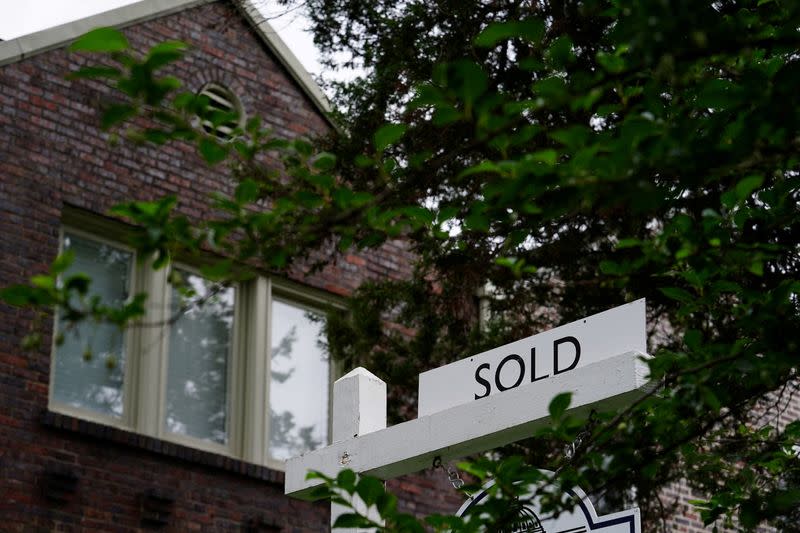US bond yield drop suggests lower mortgage rates may be coming

By Makailah Gause
NEW YORK (Reuters) - The financial market upheaval of the last several days may soon offer a silver lining to millions of U.S. households: Mortgage rates look set to fall further, offering an opening for those eager to get a toehold in an expensive housing market and an opportunity for others who borrowed at high rates to refinance.
Just how fast they decline from here is unclear - some analysts see the process taking months to play out. But a big drop in yields on the U.S. government securities most influential in determining home loan costs likely means mortgage interest rates will keep trending down from last week's six-month lows of around 6.70% for a 30-year fixed-rate mortgage, the most popular U.S. home loan.
The phenomenon is already stoking interest: Internet searches for "refi" and "mortgage refinance" on Monday jumped to the highest in at least the last 90 days, according to Google Trends data, and were about double the number on July 28.
"The last couple of days have been very busy for us with several enquiries coming in and we expect that trend to continue," said Alex Elezaj, chief strategy officer at United Wholesale Mortgage.
Still, it may be a bit early for that interest to translate into action.
"People are definitely inquiring about where rates are and when it's time to refinance. But so far, for most people, the rates haven't dropped enough to make it worth their while to refinance," said David Battany, executive vice president, capital markets at Guild Mortgage.
While more than 4 million mortgages feature interest rates of 6.5% or higher, according to Intercontinental Exchange's ICE Mortgage Monitor, a majority of outstanding loans sport rates below that, leaving some distance still for rates to fall before it becomes advantageous to foot the cost of refinancing in order to lock in a lower rate.
"It only makes sense to consider refinancing if mortgage rates drop two percentage points below your current mortgage," said Patricia McCoy, a professor at Boston College Law School. "If somebody's current mortgage is at 6%, it would probably only make sense to refinance if mortgage rates fall down to 4% or lower, and we're a long ways from that."
WAITING ON THE FED
The Federal Reserve is now expected to start cutting interest rates soon, but how quickly that offers a lift to a housing market that has struggled to find its footing remains unknown. Sales of existing homes fell for a fourth straight month in June, but economists expect the Fed's coming pivot to foster a modest rebound later this year.
Home loan application volumes plunged beginning in early 2022 as the Fed geared up to raise interest rates to fight what rapidly evolved into the worst inflation outbreak since the early 1980s. Mortgage interest rates more than doubled between January and October 2022 to their highest in more than two decades, north of 7% and eventually topping out around 8% last year.
Amid poor home affordability - between rising mortgage costs and home prices lifted to record highs by a constrained supply of houses for sale - applications for loans to buy a home sank to the lowest in 30 years last October and remain near those levels today, according to data from the Mortgage Bankers Association.
The rapid rise in interest rates as the Fed raised its benchmark rate from near zero in March 2022 to its current range of 5.25%-to-5.50% by July 2023 also stifled loan refinance activity.
But mortgage rates are now more than a full percentage point below their peak levels from late 2023, and the 10-year U.S. Treasury yield - hugely influential in setting home loan rates - is now down by roughly half a percentage point since July 24.
While refinancing applications remain low by historical measures, they did recently creep up to a two-year high and MBA's weekly data show they now account for nearly 40% of overall application volumes, up from around 30% just a few months ago and around the highest of the Fed's tightening cycle.
The number of outstanding high-interest rate mortgages continues to grow, the ICE data shows, meaning at least some borrowers could soon be in position to refinance should rates keep dropping.
"It should be good for home buyers and home sellers, because we will find a new equilibrium, and that will be a clearing price for more sales and even for more refis, but it's exceedingly difficult to see us getting back to where we were before," said Isaac Boltansky, managing director and director of policy research at BTIG.
"We're not going to see the lows that we saw during the COVID crisis anytime soon, if ever again."
(Additional reporting by Dan Burns and Nupur Anand in New York; Editing by Lananh Nguyen and Andrea Ricci)